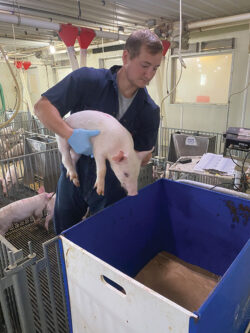
Features
Animal Health
This little piggy needs less zinc
By James Careless
Finding safe alternative options to zinc oxide for feeding just-weaned piglets.
 So-called ‘weanling pigs’ who are moved too abruptly to a solid diet with high acid-binding characteristics can experience increases in gastric pH.
Photo: Images courtesy of Kansas State University
So-called ‘weanling pigs’ who are moved too abruptly to a solid diet with high acid-binding characteristics can experience increases in gastric pH.
Photo: Images courtesy of Kansas State University The swine industry practice of weaning piglets at two to three weeks in age (rather than at 10 to 12 weeks as occurs in nature) and moving them from sow’s milk to a dry cereal-based diet can come with consequences.
Due to their young ages, these pigs – ‘weanling pigs,’ as they are called – do not have fully developed gastrointestinal tracts and their stomachs’ hydrochloric acid production is limited. As a result, moving them abruptly to a solid diet that typically has high acid-binding characteristics can increase the weanling pigs’ gastric pH. This can decrease their ability to digest protein, allowing opportunistic pathogens to compromise their digestive tracts.
To head off these consequences, many swine farmers add Zinc Oxide (ZnO) to their weanling pigs’ dry feed.
“Research has shown pharmacological levels of Zinc (Zn) typically provided from ZnO improves nursery pig performance and reduced the occurrence of post-weaning diarrhea,” says Ethan Stas, a graduate research assistant in swine nutrition at Kansas State University’s department of animal sciences and industry in Manhattan, Kansas. “However, feeding high levels of Zn leads to more excretion in the feces which ultimately gets spread on crop land contributing to heavy metal accumulation in the environment.”
Such is the level of concern about the accumulation of zinc in the soil from pig manure, that the European Union has restricted the use of pharmacological levels of Zn in weanling pig diets, and many countries are beginning to follow a similar path. “In addition, the use of ZnO in livestock diets is often discussed as a risk factor for the selection of methicillin-resistant Staphylococcus aureus (MRSA) which can be a health concern for humans,” says Stas. “Therefore, the swine industry has focused much attention on alternative strategies to provide some of the same benefits as feeding pharmacological levels of Zn to weanling pigs.”
At KSU’s Swine Day 2022 on November 17, 2022, Stas discussed these strategies while presenting the research paper, ‘Effects of Varying the Acid-Binding Capacity-4 in Diets Utilizing Specialty Soy Products with or without Pharmacological Levels of Zinc on Nursery Pig Performance’. Co-authored with Alan J. Warner, Chad W. Hastad, Mike D. Tokach, Jason C. Woodworth, Joel M. DeRouchey, Robert D. Goodband, and Jordan T. Gebhardt, this paper examines the results of a pig research trial to evaluate the effects of acid-binding capacity-4 (ABC-4) feeds with and without pharmacological levels of Zinc included on nursery pig performance.
“Several studies have been conducted evaluating the acid-binding capacity of ingredients and diets intended for weanling pigs,” says Stas. “Results have shown diets formulated to low acid-binding capacity values can improve nursery pig performance compared to high acid-binding capacity diets. Additionally, low acid-binding capacity diets have shown similar performance to diets utilizing pharmacological levels of Zn.”
The study
To take a quantitative look at options to Zn-enhanced weanling pig feed, Stas and his research team members created a trial using 1,057 weanling pigs. They were assigned to one of four dietary treatment groups based on their initial weights. Each treatment group had 12 pens of pigs assigned to it, with an initial average of 22 pigs per pen.

Research team members studied more than 1,000 weanling pigs and looked at weight, feed intake, gain, feed efficiency and more.
The four treatment groups were as follows: the first group had a low ABC-4 diet without Zn added; the second had a high ABC-4 diet without Zn added; the third group had a low ABC-4 diet with Zn added; and the fourth had a high ABC-4 diet with Zn added.
The feeding trials were done in two phases. Phase One ran for a week, followed by Phase Two for two weeks. After that, all 1,057 weanling pigs were fed the same diet for three weeks.
That’s the basics. To get into the nitty-gritty, the low ABC-4 diets contained 13.0 and 10.75 per cent novel soy protein concentrate (AX3 Digest; Protekta; Plainfield, IN). Meanwhile, the high ABC-4 diets contained 15.85 and 13.15 per cent enzymatically treated soybean meal (HP 300; Hamlet Protein; Findlay, OH), which replaced the soy protein concentrate on an SID Lys (standardized ileal digestible lysine) basis.
According to Stas and his co-authors’ research paper, the novel soy protein concentrate and enzymatically treated soybean meal were measured to have ABC-4 values of -13 and 753 meq/kg, respectively. “The low ABC-4 diets without ZnO were formulated to 150 and 200 meq/kg in Phase One and Two, respectively,” it said. “Replacing novel soy protein concentrate with enzymatically treated soybean meal increased the ABC-4 of the diet by approximately 104 to 127 meq/kg.”
The weanling pigs’ diets that included Zinc were mixed to deliver approximately 2,000 PPM of Zn from ZnO in Phases 1 and 2. “The ZnO increased the ABC-4 of the diet by approximately 60 to 65 meq/kg,” the KSU research paper said. “Diets were formulated to contain 1.36 per cent (Phase One) and 1.42 per cent (Phase Two) SID Lys and met or exceeded other nutrient requirement estimates established by the NRC.
Unfortunately, an outbreak of Porcine Reproductive and Respiratory Syndrome (PRRS) among the four test groups ran the risk of distorting the weight gain measurements due to effects from this viral illness. To compensate for this distortion, the researchers weighted each pen of pigs. They then calculated feed disappearance on a weekly basis to determine Average Daily Gain (ADG), Average Daily Feed Intake (ADFI), and Feed Efficiency (F/G).
The results
According to the KSU research group’s results, the pigs who were fed a low ABC-4 without Zn diet showed improved ADG and F/G during the trial, compared to those eating high ABC-4 feed without Zn. However, no differences in ADG and F/G were observed between the groups receiving Zn in their feed, whether they were eating a low or high ABC-4 diet. Meanwhile, pigs fed a high ABC-4 diet without Zn had a higher removal/mortality rate than the other three groups.
“Overall, there was an ABC-4 × ZnO interaction (P = 0.002) observed where pigs fed a high ABC-4 had increased (P < 0.05) removals and mortalities when ZnO was not present, and no differences (P > 0.10) due to ABC-4 level were observed when ZnO was added,” said the KSU research paper. “For economics, there was an ABC-4 × ZnO interaction (P ≤ 0.039) where pigs fed low ABC-4 diets had increased (P < 0.05) gain value, feed cost, and IOFC when ZnO was not present, and no differences (P > 0.10) due to ABC-4 level were observed when Kansas State University Agricultural Experiment Station and Cooperative Extension Service ZnO was added.”
The takeaway
For those who find the last paragraph above challenging, here’s the plain language summary that swine farmers will want to hear. “The incorporation of low acid-binding ingredients (avoiding high acid binding ingredients) in the diets of weanling pigs can help to maintain an acidic stomach pH and improve gut health and nutrient utilization,” says Stas – without adding Zinc to their diets. “However, further research is warranted to determine the optimal acid-binding capacity value for a specific age or weight range of a weanling pig, as well as at what point as acid-binding capacity of the diet increases does performance start to diminish. Additionally, do various formulation strategies to achieve a low acid-binding capacity diet yield the same or different results.”
The bottom line: Transitioning weanling pigs from sow’s milk to low ABC-4 dry feed can help them avoid the digestive and illness-related issues associated with their underdeveloped gastrointestinal tracts at this time. In turn, this allows swine farmers to stop adding this heavy metal to the soil through this feeding process, which is a win-win for everyone.
Print this page